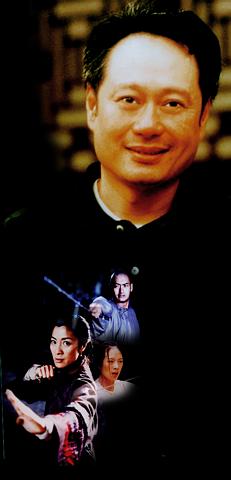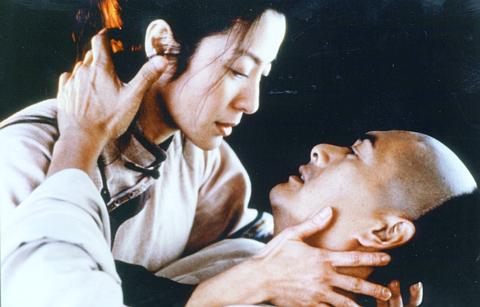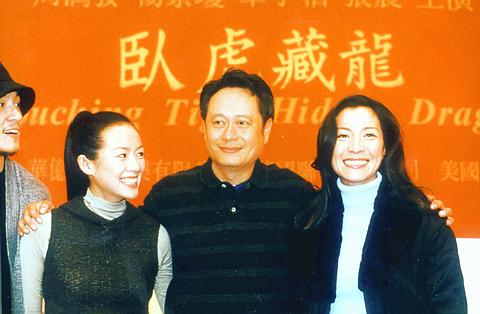Five months of toiling around China to shoot his latest film hasn't made Ang Lee lose his sense of humor. That's clear when he responds to suggestions that Western audiences might lump his Crouching Tiger, Hidden Dragon (
"It's just like opening a Chinese restaurant [in the West]," he says. "You have to go step-by-step. At the early stage, you offer some chop suey. And little by little you present more delicacies ... until they become dainty eaters of Chinese food."
That's Lee's way of saying this film is going to be extremely different from his others. At 45, the award-winning director is, for the moment, giving up art-house dramas like Eat Drink Man Woman for a little bit of light-hearted indulgence. When the world was curious about what his new film would be like after six serious dramas, he made it very clear.

Yes, it's a kung fu extravaganza inspired by a latent childhood fascination with the martial arts. And, yes, by being such it is packed with intense -- some would say drawn out -- fight scenes that combine supernatural kung fu with Matrix-style choreography.
But it's not Bruce Lee, chopping, hacking, flexing and screaming his way through a threadbare plot. Nor is it your typical Jackie Chan fare.
No, like all of Lee's renowned films, this one has plot, albeit one embellished with lots of fighting. And for this, Lee is unrepentant. He can afford to be. At the Cannes premiere of the film in May, Western viewers either thought it was the best damn chop suey they'd ever had or that it was simply a tremendous film. Feted with 10 minutes of applause and calls of "bravo, bravo," film critics and journalists were left wondering why the film wasn't registered for competition. Lee's answer seemed to tell just how far the Pingtung-born director has come: "It doesn't matter to me. I just feel sorry for my staff and actors who deserve the awards."

PHOTO: COURTESY OF BUENA VISTA FILM
A SUCCESSFUL RUN
Lee is no stranger to awards. In 1995, his second film, The Wedding Banquet, won a Golden Bear, the top honor of the Berlin Film Festival. And his fourth work and first English-language film -- Sense and Sensibility -- brought him to Hollywood and earned his team two Golden Globes and a trip to the 1996 Oscars, where the Jane Austin adaptation was nominated in seven categories, including Best Picture and Best Director. It won Emma Thompson the award for Best Screenplay adaptation.
Lee built his reputation by delving into dramas in which family members struggled with social conventions and with each other. This is best observed in his Father Knows Best trilogy: Pushing Hands, The Wedding Banquet and Eat Drink Man Woman.

PHOTO: COURTESY OF BUENA VISTA FILM
Such family dramas extended to Sense and Sensibility and The Ice Storm. The latter two won him widespread acclaim in the US, and proved his artistic style and range, showing he could do much more than present cultural conflicts.
"But I've always wanted to try new adventures. In fact, after Eat Drink Man Woman I wanted to shoot a martial arts film," says Lee. "I've said all I wanted to say in the five family dramas."
The world of martial arts was the stuff of Lee's childhood fantasies. His desire to return to a bygone era of Chinese society is influenced by Taiwan's old directors Lee Han-hsian (
"But when we actually went to China, we realized so many things have changed, and that those cinematic classic China impressions were also ones that were woven by my predecessors," Lee says. "So you have to rediscover the old Chinese feeling in your memory and try to market it to a contemporary audience."
As a Taiwanese director, shooting in China, working with a Hong Kong crew and also some American or American-Chinese staff, Lee says his new film is a cluster of disparate facets of the "China fantasy" held by Chinese people from different parts of the world. "Maybe the classic China has already gone with the wind, and we were just trying to capture and scrape together the beautified, often abstract Chinese impressions," Lee says, half jokingly.
Lee's ambition is to blend the flying kung-fu fights with the more dramatic tension that he excels at. In other words, he sees Crouching Tiger as distinct from Jackie Chan's fight-oriented films; it is, perhaps, his attempt to advance a new genre -- which might be dubbed "the martial arts drama."
Fights in Western action films are visually less fancy than Chinese ones, Lee says, but they are possessed of a deeper emotional involvement to engage the audience, which usually identifies with the characters. This is where Lee intends to strengthen the beautiful, dance-like kung fu. "If the fighting contains not only fierceness but also inner tensions of the plot, it brings more thrill to the audience," he says.
RESISTING HOLLYWOOD
Lee's preciseness and self-awareness shows in his ability to cross between genres, and also in his role as a director confronting different cultures. Lee says his Chinese language films are normally characterized as popular drama films in the Asian market. But in the US, they are generally marketed as "subtitle" or art-house films, whereas his English language films never face such distinctions.
"Interestingly, I realize that I am more self-conscious to want to make an art film when shooting English language films," he says. "Perhaps at those times I was inside Hollywood, so I tended to be more resistant to Hollywood conventions."
"I have a desire to make an American film that is more genuine than that made by local Americans," Lee says. The Ice Storm is a perfect example of such artistic achievement. The film is set in 1973 suburban Connecticut and chronicles the destructive forces that were tearing apart the social fabric of a post-Vietnam society that was careening toward Watergate. Lee was lauded for successfully crystallizing the chaotic period in contemporary American history, a time when he neither spoke English or had even visited the country. "Sometimes if you're too precise, it won't look like a typical American film, and consequently something special happens," he says.
Lee says he didn't set out to prove himself to Western audiences. "I just choose stories that intrigue me and try to make films of artistic value," he says. Few people would deny that he has done just that -- time and time again.

June 2 to June 8 Taiwan’s woodcutters believe that if they see even one speck of red in their cooked rice, no matter how small, an accident is going to happen. Peng Chin-tian (彭錦田) swears that this has proven to be true at every stop during his decades-long career in the logging industry. Along with mining, timber harvesting was once considered the most dangerous profession in Taiwan. Not only were mishaps common during all stages of processing, it was difficult to transport the injured to get medical treatment. Many died during the arduous journey. Peng recounts some of his accidents in

“Why does Taiwan identity decline?”a group of researchers lead by University of Nevada political scientist Austin Wang (王宏恩) asked in a recent paper. After all, it is not difficult to explain the rise in Taiwanese identity after the early 1990s. But no model predicted its decline during the 2016-2018 period, they say. After testing various alternative explanations, Wang et al argue that the fall-off in Taiwanese identity during that period is related to voter hedging based on the performance of the Democratic Progressive Party (DPP). Since the DPP is perceived as the guardian of Taiwan identity, when it performs well,

The Taiwan People’s Party (TPP) on May 18 held a rally in Taichung to mark the anniversary of President William Lai’s (賴清德) inauguration on May 20. The title of the rally could be loosely translated to “May 18 recall fraudulent goods” (518退貨ㄌㄨㄚˋ!). Unlike in English, where the terms are the same, “recall” (退貨) in this context refers to product recalls due to damaged, defective or fraudulent merchandise, not the political recalls (罷免) currently dominating the headlines. I attended the rally to determine if the impression was correct that the TPP under party Chairman Huang Kuo-Chang (黃國昌) had little of a

A short walk beneath the dense Amazon canopy, the forest abruptly opens up. Fallen logs are rotting, the trees grow sparser and the temperature rises in places sunlight hits the ground. This is what 24 years of severe drought looks like in the world’s largest rainforest. But this patch of degraded forest, about the size of a soccer field, is a scientific experiment. Launched in 2000 by Brazilian and British scientists, Esecaflor — short for “Forest Drought Study Project” in Portuguese — set out to simulate a future in which the changing climate could deplete the Amazon of rainfall. It is